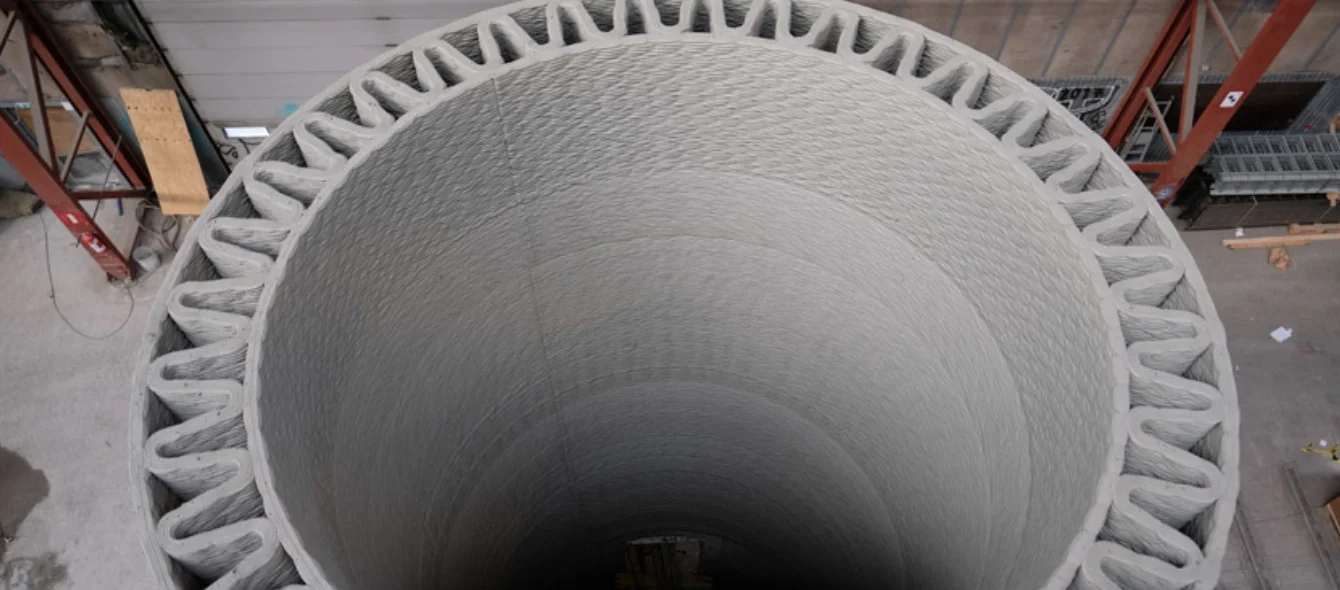Onshore wind turbines are advancing in terms of both performance and size. Manufacturers are currently outdoing each other with turbines capable of producing more than five megawatts of power at full load. It isn’t rare to see the towers on which they are perched extending over 100 metres into the sky. However, the quest for lofty heights has technical limits. The higher – and thus heavier – the towers, the more difficult it is to transport them. This is the problem for which GE has come up with a solution. The US industrial giant has installed onshore and offshore wind farms, hydroelectric systems, storage technology as well as solar and grid solutions with a total capacity in excess of 400 gigawatts the world over. Its GE Renewable Energy division is working on using 3D printers to produce sections of wind turbine towers directly on site.
Foundation decisive for height
Conventional towers are usually made of reinforced concrete elements and weigh hundreds of tons. And they have been growing, averaging 20 metres in the 80s and 84 in 2017. New wind turbines often throne 100 metres above ground. The higher they reach, the more stable they have to be. After all, besides bearing more weight, they have to be sturdy enough to withstand being blown over by the wind, which gets stronger the higher they climb.
This is why GE has decided to take a new approach to plant engineering by teaming up with Swiss building materials company LafargeHolcim, which supplies its products to construction projects in 70 countries, and 3D design printing specialist COBOD International. In October of 2019, the partners printed the first prototype of a tower base – the bottom of a wind turbine tower – using a 3D printer in Copenhagen, Denmark. This summer, the companies announced they will continue working on the project in order to make the technology ready for market.
Developing wind turbine towers with 3D-printed concrete bases
The prototype – a ten-metre base – consists of endless layers of concrete. Individually applied by a 3D printer, they form a cylinder. The cylinder wall is made up of three layers: an outer and inner, continuous, layer sandwiching an intermediate layer containing cavities. This makes the structure lighter than solid concrete and extremely stable. GE wants to improve the process before putting the towers into serial production. Bonding is not just down to the materials used. One must cure a layer before applying another one on top of it. This is extremely challenging as the component becomes unstable if curing time is too long, keeping the layers of concrete from bonding to one another.
No need for complex transport
Since this manufacturing method allows for components to be produced where they are used, reducing transport needs to the building materials and printer, wind turbines can rest on a much broader base in the future. So far, the area covered by the parts has been limited to 4.5 square kilometres, as bigger payloads cannot be transported on the road without taking extreme measures and incurring additional costs. Bigger bases translate into higher towers. According to GE, this would make hub heights of 200 metres a breeze. 3D printers could produce tower parts of up to 80 metres in height in a single piece. This would enable wind turbine systems as high as the Main Tower in Frankfurt am Main to go into series production.
Higher yield
Based on expert calculations, this would also pave the way for a significant increase in system yield. This is because wind turbine output is directly linked to hub height: an average 5 MW turbine resting on an 80 metre tower can output some 15.1 gigawatt hours (GWh) of electricity per year. If it were atop a 160 metre tower, yield would rise to 20.2 GWh, jumping by one-third.
The reason for this is that rotor blades can trap bigger airstreams the higher they get. The greater the distance from the surface of the earth – and thus from obstruction – the higher the wind speeds. According to Swiss energy association Suisse Eole, air travels at an average of five metres per second ten metres above ground, 7.5 at 100 metres and 8.25 at a height of 200 metres. This explains why taller wind turbine systems can generate more electricity. As the turbines themselves also constantly benefit from technological improvements, yield increases in coming years could be much more significant.
GE has already established a roadmap with its project partners for achieving this goal. While COBOD continues to improve 3D printing, LafargeHolcim experts will focus on blueprinting and using tailormade concrete building material. Meanwhile, GE Renewable Energy will handle commercialisation. The concept is scheduled to be marketable by 2023.
“We’re convinced that large-scale manufacturing will bring trailblazing potential for the wind industry. Concrete printing has made leaps and bounds in the last five years. And we firmly believe that it is getting closer to real-life application in the industrial world,” says Matteo Bellucci, Advanced Manufacturing Technology Leader at GE Renewable Energy.
Further projects in test phase
The GE project is not the first to involve 3D printing in the wind energy business. In various collaborative ventures, including one with the the US Energy Ministry’s National Renewable Energy Laboratory, US startup RCAM Technologies has been developing concepts for using 3D printing to build onshore and offshore wind turbine systems since 2017. However, they are still in the trial phase. This means General Electric could indeed be the first to introduce printed wind energy towers to the market.
Photo credit: GE Renewable Energy/LafargeHolcim/COBOD
